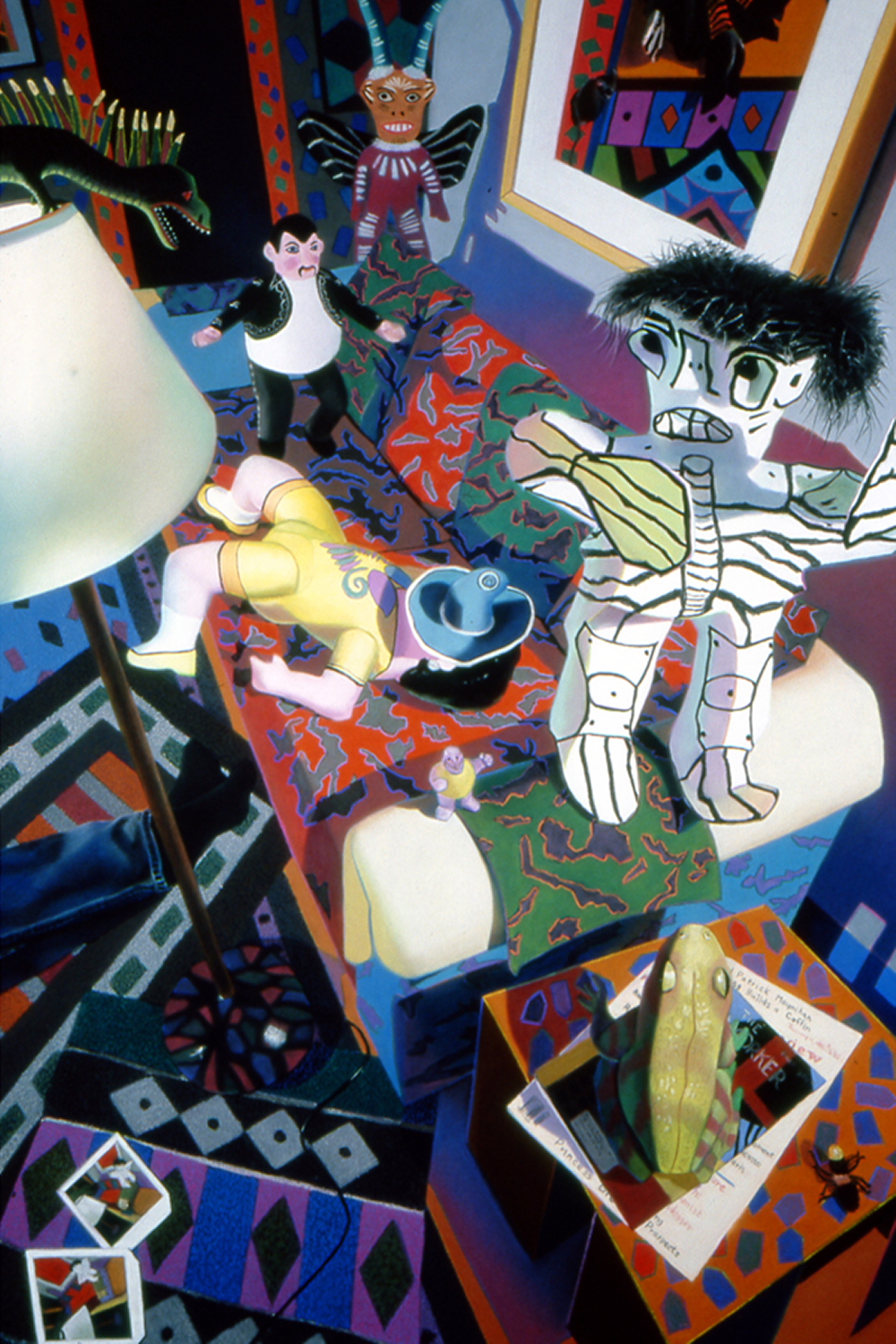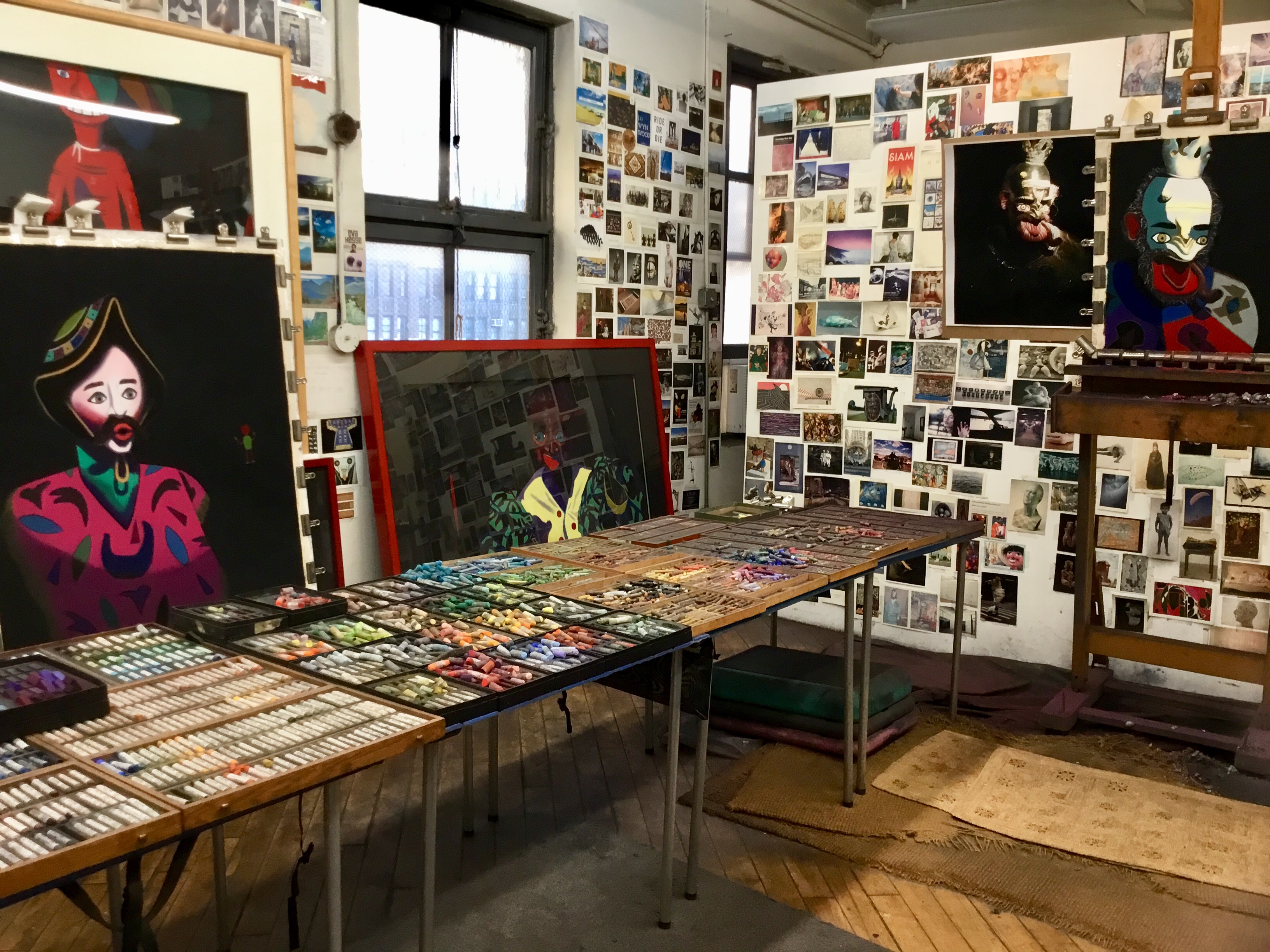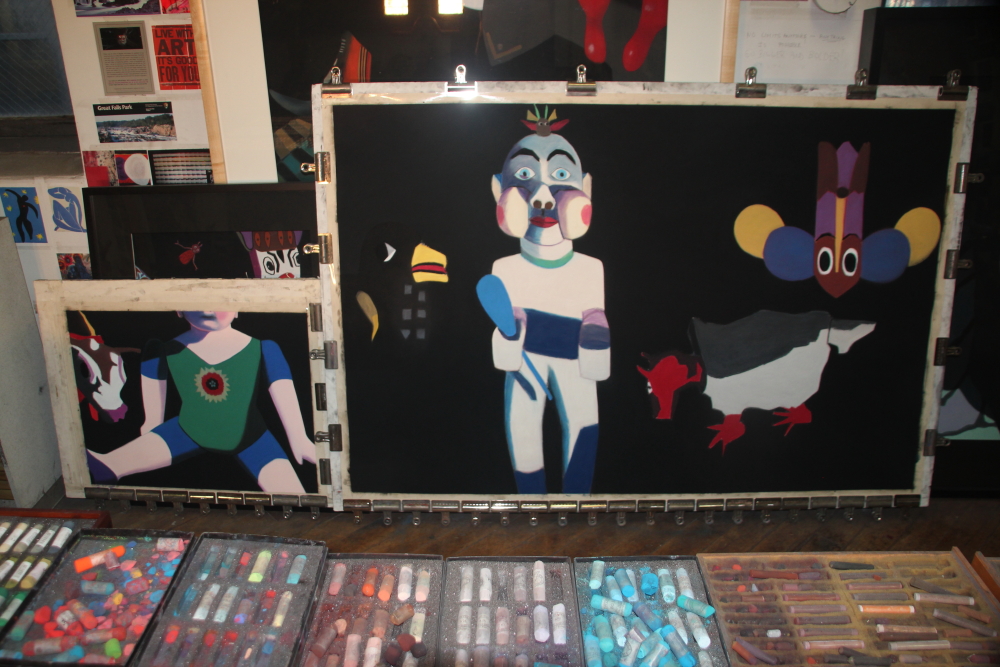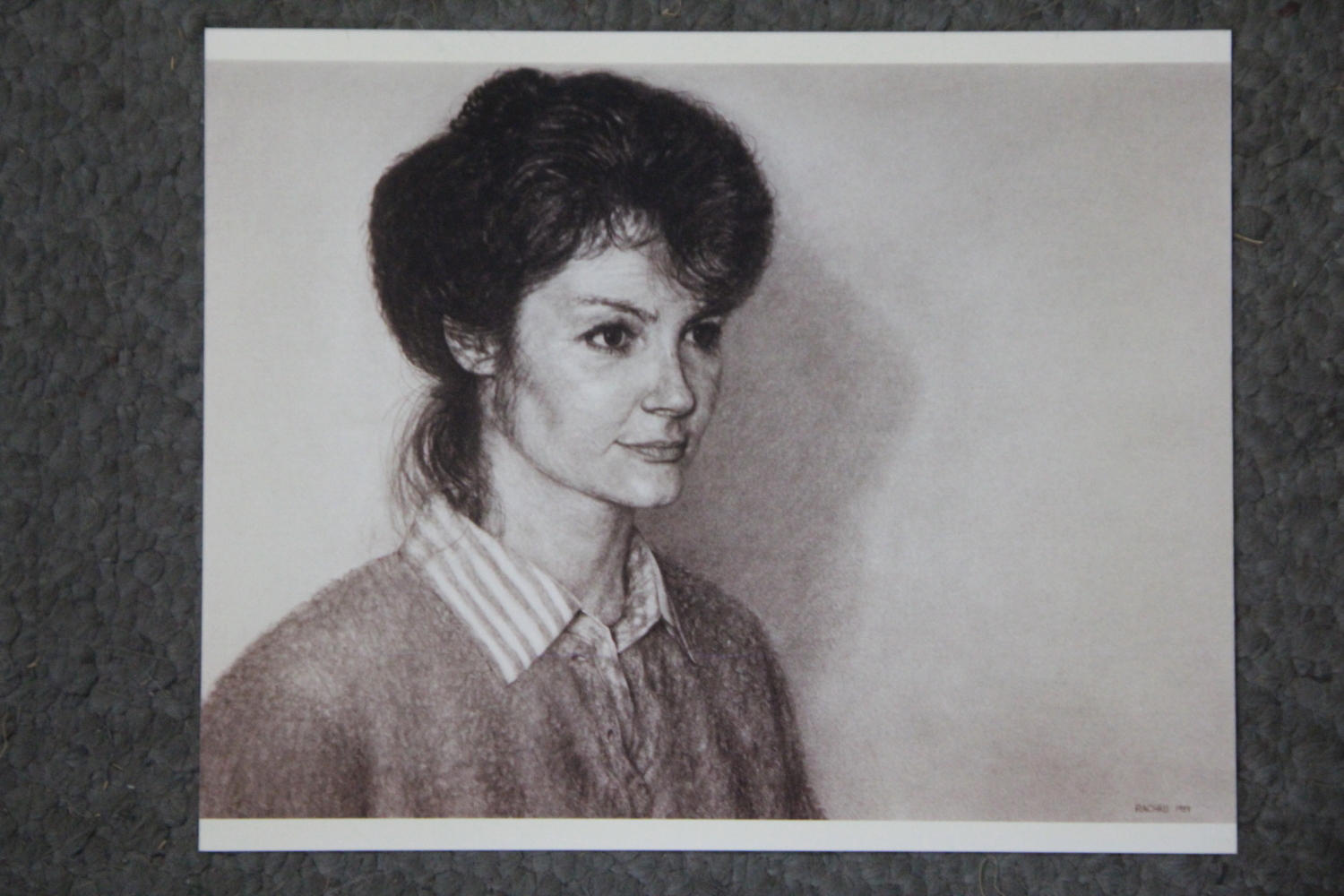Blog Archives
Q: How do you persist despite the haters, nay-sayers, etc.? (Question from Bold Journey Publishing)
Posted by barbararachkoscoloreddust
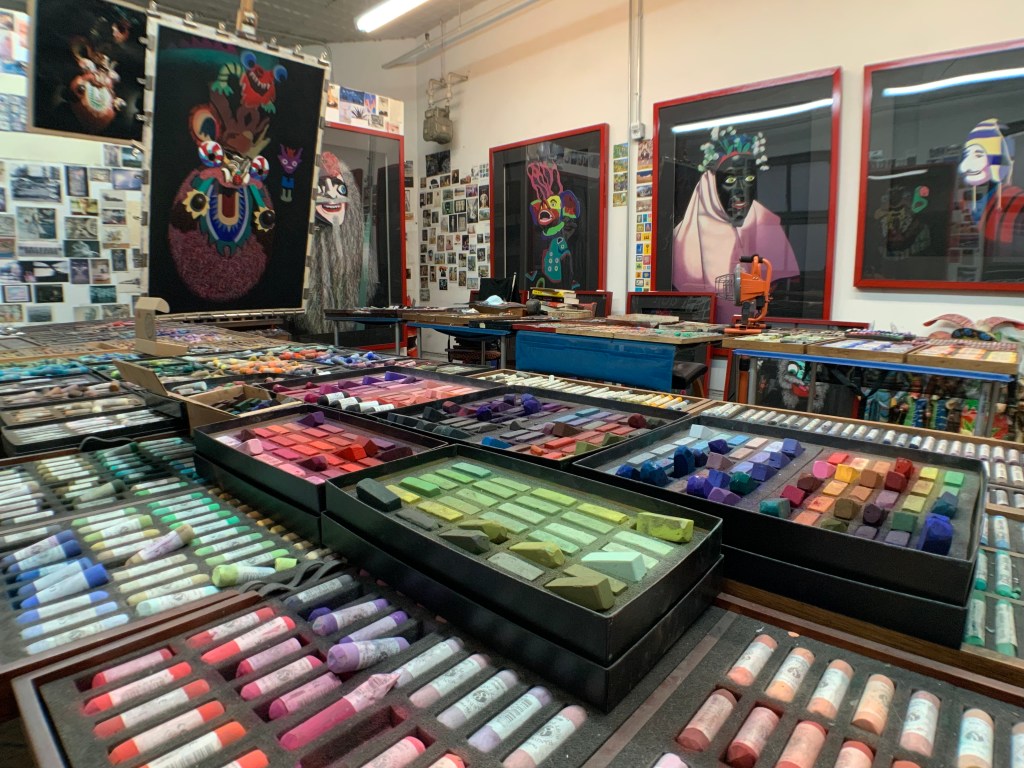
Barbara’s Studio
A: There are so many obstacles to art-making and countless reasons to just give up. When you really think about it, it’s amazing that great art gets made at all. So why do we do it? For artists I believe it’s all about making our time on earth matter, about devotion to our innate gifts, and a deep love of our hard-fought creative process.
I have been a full-time professional artist for 37 years. How and why do successful artists persist? It helps a lot to be stubborn! We just keep digging in that much deeper. Making art is a most noble and sacred calling – you know this if you are one of the called – and that’s what separates those of us who are in it for the long haul from the wimps, fakers, and hangers-on. I say to my fellow artists who continue to work despite the endless challenges, we artists who continue to struggle every day for recognition of our gifts are true heroes!
These words below by Mary Gabriel in Ninth Street Women, published in 2017, ring true for artists. It’s good, even for me, to occasionally reread them and be reminded.
The obstacles faced by women who hoped to leave a mark on humankind have, through the millennium, varied in height but not in stubborn persistence. And yet, a great many women have stubbornly ignored them. The desire to put words on a page or marks on a canvas was greater than the accrued social forces that told them they had no right to do so, that they were excluded by their gender from that priestly class called artist. The reason, according to Western tradition, was as old as creation itself: For many, God was the original artist and society had assigned its creator a gender – He. The woman who dared to declare herself an artist in defiance of centuries of such unwavering belief required monstrous strength, to fight not for equal recognition and reward but for something at once more basic and vital: her very life. Her art was her life. Without it, she was nothing. Having no faith that society would broaden its views on artists by dethroning men and accommodating women, in 1928 [Virginia] Woolf offered her fellow writers and painters a formula for survival that allowed them to create, if not with acceptance, then at least unimpeded. A woman artist, she said, needed but two possessions: “money and a room of her own.”
Furthermore, I think I persist because I do not believe in “big breaks.” Big breaks may sometimes happen, but in my experience an artist’s life is made up of single-minded dedication, persistence, hard work, and lots of small breaks. I recently finished reading “Failing Up: How to Take Risks, Aim Higher, and Never stop Learning” by Leslie Odom, Jr. I like what he has to say to artists here:
The biggest break is the one you give yourself by choosing to believe in your wisdom, in what you love, and in the gifts you have to offer the waiting world.
Comments are welcome!
Posted in 2024, An Artist's Life, Inspiration, Quotes, Studio
Tags: acceptance, accommodating, accrued, allowed, amazing, art-making, artists, assigned, “Failing Up”, ”Ninth Street Women”, belief, believe, big breaks, Bold Journey Publishing, broaden, called, canvas, centuries, challenges, choosing, continue, countless, create, creation, creative, creator, declare, dedication, deeper, defiance, desire, despite, dethroning, devotion, digging, endless, excluded, experience, fakers, fellow, finished, forces, formula, full-time, furthermore, gender, greater, hangers-on, happen, hard work, hard-fought, haters, height, heroes, herself, humankind, ignored, innate, itself, Leslie Odom, long haul, making, Mary Gabriel, matter, millenium, monstrous, nay-sayers, needed, nothing, obstacles, occassionally, offered, original, painters, persist, possessions, priestly, process, professional, published, reading, reason, recently, recognition, reminded, required, reread, reward, sacred, separates, single-minded, social, society, something, sometimes, strength, struggle, stubborn, Studio, successful, survival, tradition, unimpeded, unwavering, Virginia Woolf, waiting, Western, wisdom
Q: When did you decide and what prompted you to become an artist? (Question from artamour)
Posted by barbararachkoscoloreddust

A: In the mid-1980s I was a thirty-three-year-old Navy lieutenant, working a soul-crushing job as a computer analyst on the midnight shift in a Pentagon basement. We were open 24/7 and supported the Joint Chiefs of Staff.
Remembering the joyful Saturdays of my youth in New Jersey when I had studied with a local painter, I enrolled in a drawing class at the Art League School in Alexandria, Virginia. I loved it! I took more classes and became a highly motivated, full-time art student who worked nights at the Pentagon. After two years and as my skills improved, I discovered my preferred medium – soft pastel on sandpaper.
I knew I had found my calling, submitted my resignation, and left the active duty Navy. On October 1, 1989 I became a professional artist. However, I remained in the Navy Reserve for another fourteen years, working at the Pentagon one weekend a month. On November 1, 2003, I retired as a Navy Commander.
Comments are welcome!
Posted in 2022, An Artist's Life, Inspiration
Comments Off on Q: When did you decide and what prompted you to become an artist? (Question from artamour)
Tags: active duty, Alexandria_VA, analyst, Art League School, artamour, artist, basement, became, calling, computer, decide, discovered, drawing, enrolled, full-time, highly, improved, Joint Chiefs of Staff, joyful, lieutenant, medium, midnight, motivated, Naval Officer Candidate, Navy Commander., Navy Reserve, New Jersey, painter, Pentagon, preferred, professioanl, prompted, remained, remembering, resignation, retired, Saturdays, soft pastel on sandpaper, soul-crushing, student, studied, submitted, supported, weekend, worked, working
Q: What makes you drawn to face masks?
Posted by barbararachkoscoloreddust
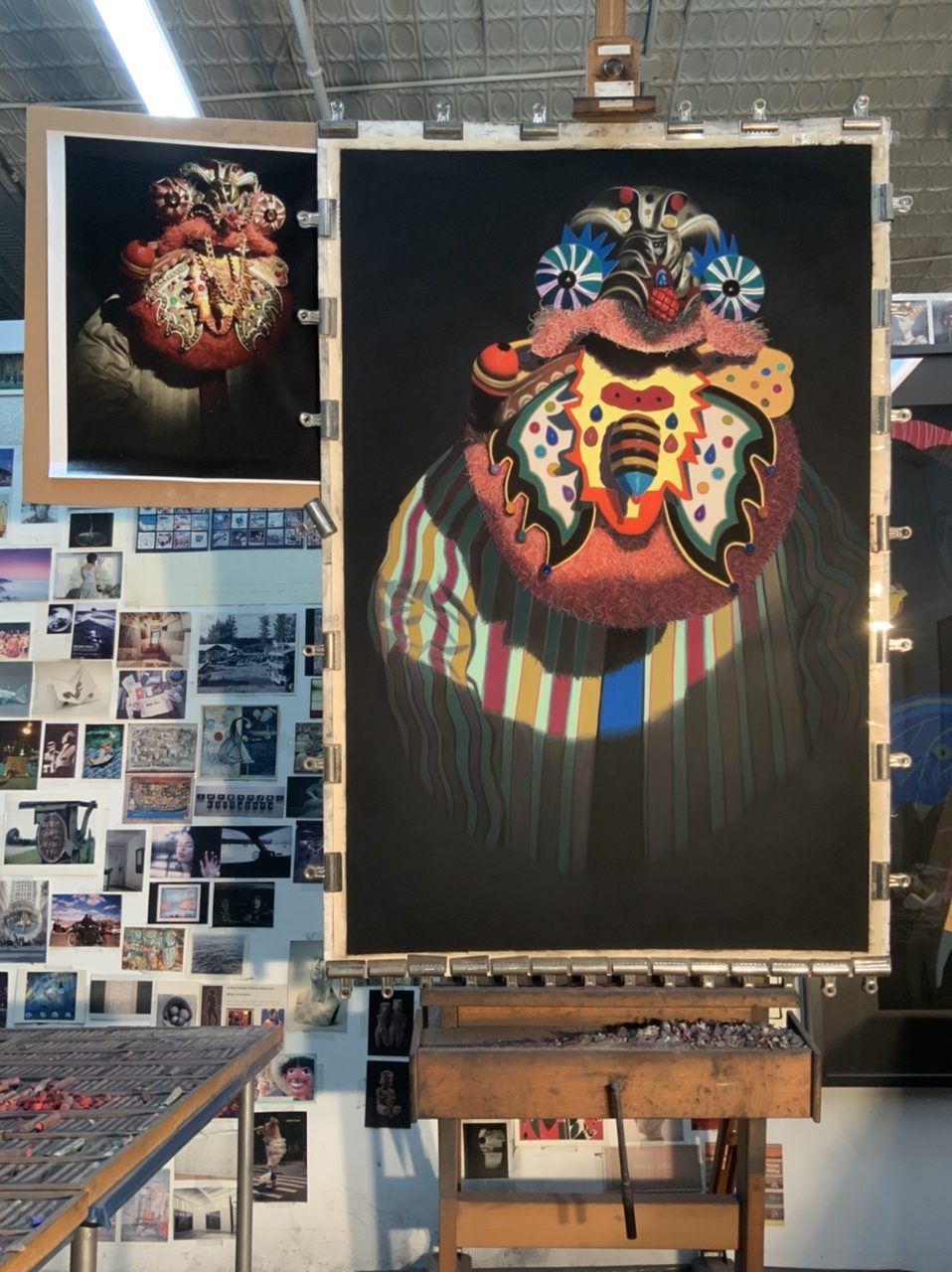
A: For me a mask is so much more than a mask. It is almost a living thing with its own soul and with a unique history. I always wonder, who created this mask? For what purpose? Where has it been? What stories would it tell if it could? In my current “Bolivianos” series I feel as though I am creating portraits of living, or perhaps once living, beings.
In a way the masks are a pretext for a return to my early days as an artist. When I resigned my Naval commission to pursue art full time, I started out as a photo-realist portrait painter. The twist is that this time I do not have to satisfy a client’s request to make my subjects look younger or more handsome. I am joyfully free to respond only to the needs of the pastel painting before me on the easel.
Comments are welcome!
Posted in 2021, An Artist's Life, Bolivianos, Inspiration, Source Material
Comments Off on Q: What makes you drawn to face masks?
Tags: almost, always, artist, ”Raconteur, before, beings, Bolivianos, client, commission, created, current, easel, face masks, full-time, handsome, history, in progress, joyfully, living, Naval, painter, pastel painting, perhaps, photo-realist, portraits, pretext, purpose, pursue, request, resigned, respond, return, satisfy, series, soft pastel on sandpaper, started, stories, subjects, unique, wonder, younger
Q: How do you think about risk? What role has taking risks played in your life/career? (Question from Emma Jacobs, VoyageMIA.com)
Posted by barbararachkoscoloreddust

A: My journey to becoming a visual artist was circuitous, to say the least. Risk-taking gave me the life and career I enjoy now.
The biggest – and scariest – risk I’ve ever taken was deciding to leave my active duty Naval career to pursue art full-time. The second most significant risk was moving to New York City in 1997. I have never regretted doing either one.
When I was 25, and a civilian, I earned my private pilot’s license and spent the next two years amassing other flying licenses and ratings, culminating in a Boeing-727 flight engineer’s certificate. Two years later I joined the Navy.
As an accomplished civilian pilot with thousands of flight hours, I had expected to fly jets in the Navy. However, women were barred from combat in those days (the 1980s) so there were very few women Navy pilots. There were no female pilots on aircraft carriers and no female Blue Angels. Women were restricted to training male pilots for combat jobs and priority was given to Naval Academy graduates. My BA was from a different university.
In the mid-1980s I was in my early 30s and a Lieutenant on active duty in the Navy. I worked a soul-crushing job as a computer analyst on the midnight shift in a Pentagon sub-basement. It was literally and figuratively the lowest point of my life. I hated my job! Not only was it boring, I was not using my hard-won flying skills. In short I was miserable – miserable and trapped because a Naval officer cannot just resign with two weeks notice.
Remembering the joyful Saturdays of my youth when I had taken art classes with a local New Jersey painter, I enrolled in a drawing class at the Art League School in Alexandria, Virginia. Initially I wasn’t very good, but it was wonderful to be around other women and a world away from the “warrior mentality” of my mostly male Pentagon co-workers. Plus, I was having fun!
Soon I enrolled in more classes and became a very motivated full-time art student who worked nights at the Pentagon. As I studied and improved my skills, I discovered my preferred medium – soft pastel on sandpaper.
Although I was certain I had found my life’s calling as a fine artist, I had grown used to a regular paycheck and the many benefits of being a Navy Lieutenant. For more than a year I agonized over whether or not to leave the Navy and lose my financial security. I’d be taking a huge risk: could I ever support myself as an artist? Was I making the dumbest mistake of my life?
Eventually, I decided I HAD TO take a leap. I simply adored making art – it challenged me to use all of my skills and talents – while I was unhappy, bored, and unfulfilled working at the Pentagon.
But once my mind was finally made up, I still could not leave. Due to geopolitical circumstances, there was a significant delay. The Navy was experiencing a manpower shortage and Congress had enacted a stop-loss order, which prevented officers from resigning for one year. I submitted my resignation effective exactly one year later: on September 30, 1989. Being stuck in a job I no longer wanted nor had the slightest interest in, was truly the longest year of my life!
Unlike most people, I can pinpoint exactly when I became an artist. I designate October 1, 1989 as the day I became a professional artist! I have never regretted my decision and I never again needed, nor had, a day job.
However, I must mention that I remained as a part-time Naval Reservist for the next 14 years, working primarily at the Pentagon for two days every month and two weeks each year. The rest of the time was my own to pursue my art career. After I moved to Manhattan in 1997, I commuted by train to Washington, DC to work for the Navy.
Finally on November 1, 2003, I officially retired as a Navy Commander. Now, I daresay, I am the rare fine artist who can point to a Navy pension as a source of income.
I love my life as an accomplished New York fine artist! With the help of two social media assistants, I work hard to make and promote the art I create. My pastel paintings and my pastel skills continue to evolve and grow, gaining wider recognition and a larger audience along the way.
In addition to making art, I have been a blogger since 2012. The audience for my blog, https://barbararachkoscoloreddust.com/ increases by 1,000 – 2,000 new subscribers each month. Today I have more than 72,000 readers!
Comments are welcome!
Posted in 2021, Alexandria (VA), An Artist's Life, Art in general, New York, NY, Studio
Comments Off on Q: How do you think about risk? What role has taking risks played in your life/career? (Question from Emma Jacobs, VoyageMIA.com)
Tags: accomplished, actuve duty, adored, agonized, aircraft carriers, Alexandria, amassing, around, art classes, Art League School, art student, assistants, audience, became, benefits, biggest, Blue Angels, Boeing-727, boring, calling, career, certain, certificate, challenged, circuitous, circumstances, civilian, commuted, computer analyst, Congress, continue, culminating, deciding, decision, designate, different, discovered, drawing class, dumbest, earned, effective, Emma Jacobs, enacted, enrolled, eventually, exactly, expected, experiencing, female, figuratively, financial, fine artist, flight engineer, flight hours, Flying, flying.skills, full-time, gaining, geopolitical, graduates, hard-won, improved, increases, initially, interest, joined, jotful, larger, licenses, lieutenant, literally, longer, lowest, making, Manhattan, manpower, medium, midnight shift, miserable, mistake, motivated, moving, my youth, myself, Naval Academy, naval officer, Naval Reservist, needed, New Jersey, New York City, notice, officers, painter, part-time, pastel paintings, paycheck, Pentagon, people, pilot, pinpoint, preferred, prevented, priority, private pilot’s license, professional, promote, pursue, ratings, readers, recognition, regretted, regular, remained, remembering, resign, resignation, resigning, restricted, risk-taking, Saturdays, scariest, second, security, shortage, significant, skills, slightest, social media, soft pastel on sandpaper, soul-crushing, stop-loss order, studied, Studio, sub-basement, submitted, subscribers, support, talents, the Navy, thousands, training, trapped, unfulfilled, unhappy, university, Virginia, visual artist, VoyageMIA, wanted, warrior mentality, Washington DC, wonderful, worked
Pearls from artists* # 443
Posted by barbararachkoscoloreddust
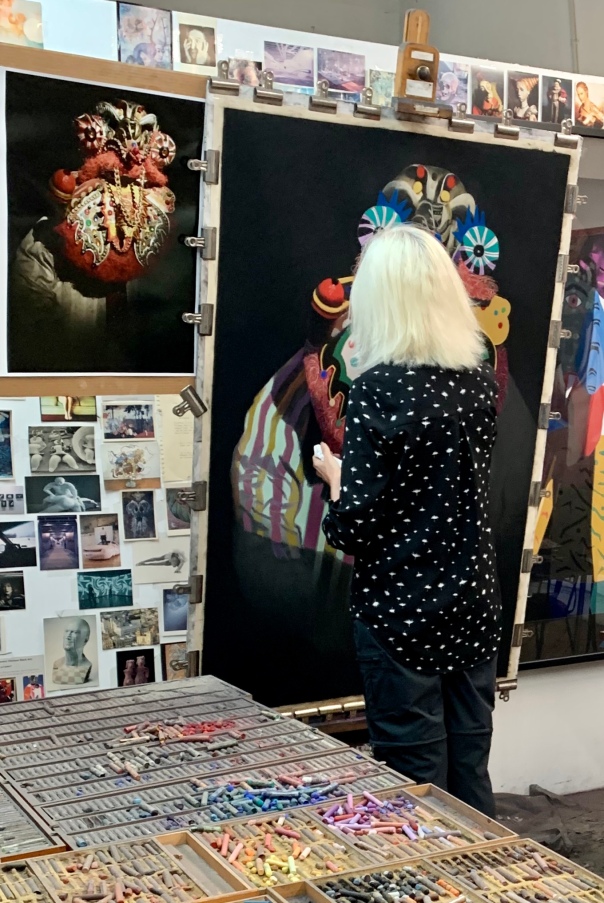
*an ongoing series of quotations – mostly from artists, to artists – that offers wisdom, inspiration, and advice for the sometimes lonely road we are on.
The theater has been good to me. It has produced great friendships, love, travel, hard work, fun, terror and pleasure. It has also offered an entire life of study. Study is a full-time engagement which includes reading books, reading people, reading situations, reading about the past and reading about the present. To study, you enter into a situation with your whole being, you listen and then begin to move around inside it with your imagination. You can study every situation you are in. You can learn to read life while life is happening.
Anne Bogart in A Director Prepares: Seven Essays on Art and Theatre
Comments are welcome!
Posted in 2021, An Artist's Life, Creative Process, Inspiration, Pearls from Artists, Quotes
Comments Off on Pearls from artists* # 443
Tags: "A Director Prepares: Seven Essays on Art and Theater", Anne Bogart, around, engagement, entire, friendships, full-time, happening, imagination, includes, inside, listen, offered, people, pleasure, present, produced, reading, situations, terrorism, theatre, travel, whole being
Q: As you reflect on your overall art career beginning with your art education, what major event stands out as an important sign that you were headed in the right direction?
Posted by barbararachkoscoloreddust
A: In 1989 I left a career in the Navy to pursue life as a full-time professional artist. In July 1996 Bryan and I were traveling in Mexico. Something told me to check the phone messages at our Virginia house so I did.
There was a message from Mia Kim, the director of Brewster Arts Ltd. on West 57th Street in Manhattan, requesting a dozen large pastel paintings for a two-person exhibition in October, just three months away!
At the time I was still living in Alexandria, Virginia so exhibiting in Manhattan – let alone securing prestigious gallery representation – seemed a far-off dream. Yes, I had sent Mia slides, but she had not seen my work in person. She first saw my “Domestic Threats” pastel paintings when I delivered them to the gallery for exhibition. The show was called “Monkey Business.”
Brewster Arts was an elegant New York gallery that specialized in Latin American Art. There was just one other non-Latina artist that Mia represented, Leonora Carrington, whom I met that October at my opening. I remember Mia introducing me and declaring to the entire crowd, “Barbara has the SOUL of a Latina.” I’ve always loved that. It was the first time I realized I was really on my way!
Brewster Arts Ltd. continued to represent my work until the gallery closed some years later.
Comments are welcome!
Posted in 2019, An Artist's Life, Art Business, Domestic Threats, Mexico, New York, NY, Pastel Painting
Comments Off on Q: As you reflect on your overall art career beginning with your art education, what major event stands out as an important sign that you were headed in the right direction?
Tags: artist, “His Mortal Enemy Was Poised Read to Strike”, beginning, Brewster Arts Ltd., continued, declaring, delivered, director, Domestic Threats, education, elegant, exhibitingliving, exhibition, far-off, full-time, gallery, house, important, in person, Latin American, Latina, Leonora Carrington, major event, Manhattan, Mexico, Mia Kim, Navy, New York, October, opening, overall art career, pastel paintings, phone messages, prestigious, professional, realized, reflect, remember, represent, representation, right direction, securing, Virginia, West 57th Street
Q: Was there a pivotal time in your life when you were forced to choose between two different paths? Do you have any regrets?
Posted by barbararachkoscoloreddust
A: In 1988 I was a Navy Lieutenant working at the Pentagon as a computer analyst. I hated my boring job! For about two years I had been taking drawing classes at the Art League School in Alexandria, VA and was rapidly improving. More importantly, I discovered that making art was endlessly fascinating and challenging.
After much soul searching, I made the scary decision to resign from active duty. Sept. 30, 1989 was my last day. I have been a professional visual artist ever since and surprisingly (to me!), have never needed a day job.
However, for fourteen years I remained in the Naval Reserve, working in Virginia one weekend a month and for two weeks each year. After I moved to New York in 1997, I used to take Amtrak to Washington, DC. I would go from my full time New York artist’s life to my part time military life. It was extremely interesting to be around such different types of people, to say the least! On November 1, 2003 I retired as a Navy Commander.
I have never, ever regretted the path I chose. I love being an artist and would not want to spend my life doing anything else.
Comments are welcome!
Posted in 2019, An Artist's Life, Studio
Comments Off on Q: Was there a pivotal time in your life when you were forced to choose between two different paths? Do you have any regrets?
Tags: active duty, Alexandria, Amtrak, Art League School, artist, boring, challenging, choose, computer analyst, day job, decision, discovered, drawing classes, endlessly, fascinating, full-time, improving, interesting, lieutenant, making art, military, moved New York, Naval Reserve, Navy, Navy Commander., part-time, paths, Pentagon, people, pivotal, professional, rapidly, regrets, regretted, remained, resign, scary, soul-searching, spend, Virginia, visual artist, Washington DC, weekend, working
Q: How many pastel paintings do you have in progress now?
Posted by barbararachkoscoloreddust
A: Making pastel-on-sandpaper paintings is a slow and meticulous process. I work full-time in my studio so that in a good year I can produce five finished pieces. Typically two are in progress at a time so that I can switch off when problems develop.
A downside to looking at a painting for months is that there comes a point when I can’t see the flaws any more. Then it’s definitely time to take a break.
When I put a painting that has been resting back onto my easel, I see it with fresh eyes again. Areas that need work immediately stand out. Problem areas become easily resolvable because I have continued to think about them while the painting was out of my sight.
Comments are welcome!
Posted in 2016, An Artist's Life, Art Works in Progress, Black Paintings, Creative Process, New York, NY, Pastel Painting, Photography, Studio, Working methods
Comments Off on Q: How many pastel paintings do you have in progress now?
Tags: again, blind spots, continued, create, develop, different, downside, easily, finished, full-time, immediately, looking, mental, meticulous, months, occur, paintng, pastel paintings, pieces, problem, problems, process, produce, progress, readily, reasolvable, resolve, resting, sandpaper, Studio, switch, typically
Q: How do you decide how much to charge for your paintings?
Posted by barbararachkoscoloreddust
A: What to charge for my work is a complex question. The prices of my pastel paintings take into account many tangible and intangible factors. Here are a few:
Sales history.
My thirty-year-long exhibition history.
The costs of maintaining a studio in New York. My overhead goes up annually, but I do not raise prices every year to offset these expenses.
The countless hours of labor, cost of art materials, framing, photography, transportation, foreign travel, etc. that go into creating a painting.
Costs for marketing, social media, advertising, website design and upkeep, ongoing education, etc.
Somewhat less quantifiable factors such as my reputation as an artist, the real demand for my work, goodwill, the fact that I work full-time as a professional artist, etc.
Comments are welcome!
Posted in 2015, An Artist's Life, Art Works in Progress, Black Paintings, Creative Process, Pastel Painting, Photography, Studio, Working methods
Tags: account, annually, art, artist, charge, complex, cost, countless, creating, decide, demand, design, education, exhibition, expenses, factors, foreign, framing, full-time, goodwill, history, hours, intangible, labor, maintaining, marketing, materials, New York, offset, ongoing, overhead, paintings, pastel, photography, prices, professional, quantifiable, question, raise, real, reputation, sales, social media, Studio, tangible, transportation, travel, upkeep, website, year
Q: How did you prepare yourself to change careers and work as a professional artist?
Posted by barbararachkoscoloreddust
A: At the age of 33 I was a Lieutenant in the Navy, working as computer analyst at the Pentagon. I was very unhappy with my job. I began looking for something else to do and discovered The Art League School in Alexandria, VA. I enrolled in classes with Lisa Semerad, then spent the next two years developing my drawing skills using black and white media (charcoal, pencils, conte crayon, etc.).
After that I moved on to color media and began studying soft pastel with Diane Tesler. During this time I was still in the Navy, working the midnight shift at the Pentagon and taking art classes during the day. I was a very motivated student.
After three years or so I was getting quite proficient as an artist, entering local juried shows, winning prizes, garnering press coverage, etc. Prior to my career change, I worked hard to develop my portrait skills. I really didn’t know how I could make a living other than by making commissioned portraits. I volunteered to run a weekly life drawing class at The Art League School in Alexandria, VA, where I made hundreds of figure drawings using charcoal.
I spent a semester commuting between Washington, DC and New York to study artistic anatomy at the New York Academy of Art. I spent another semester studying gross anatomy with medical students at Georgetown University Medical School. Over time I became skilled at making photo-realistic portraits. In 1989 I resigned from the Navy and have worked full-time as a visual artist ever since.
Comments are welcome!
Posted in 2014, An Artist's Life, Creative Process, Inspiration, Pastel Painting, Photography, Working methods
Comments Off on Q: How did you prepare yourself to change careers and work as a professional artist?
Tags: Alexandria_VA, artistic anatomy, black and white, career, change, charcoal, classes, color, commissioned, commuting, computer analyst, conte crayons, developing, Diane Tesler, drawing, enrolled, entering, figure drawings, full-time, garnering, Georgetown University Medical School, gross anatomy, juried shows, Krystyn, lieutenant, life drawing, LIsa Semerad, living, local, looking, media, midnight shift, motivated, Navy, New York, New York Academy of Art, pencils, Pentagon, photo-realistic, portrait, portraits, prepare, press coverage, prizes, professional, proficient, resigned, semester, skilled, skills, soft pastel, student, students, studying, The Art League School, unhappy, visual artist, volunteered, Washington_DC, winning, work

